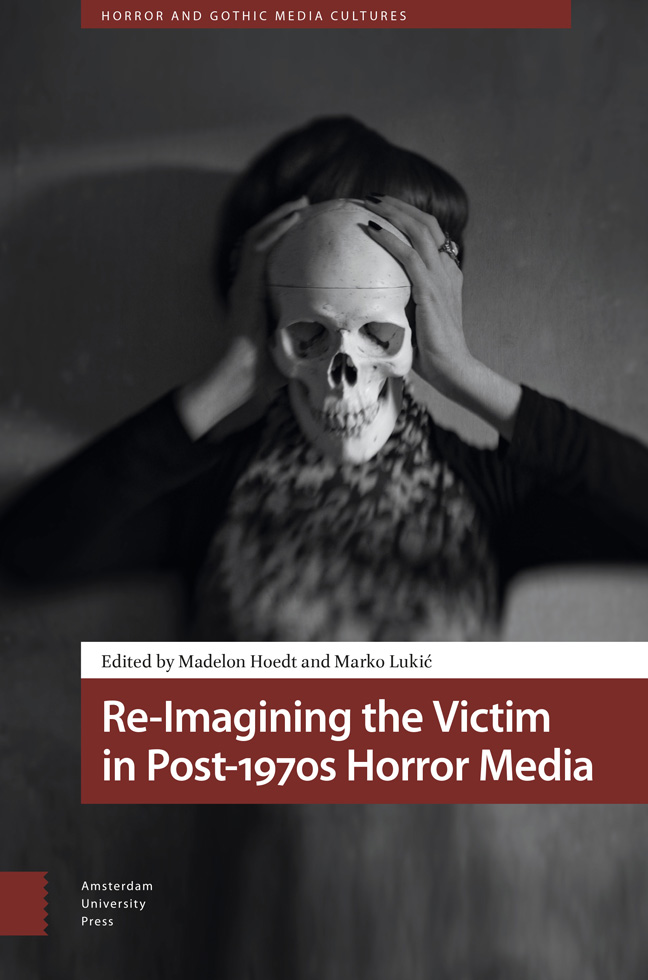Book contents
- Frontmatter
- Contents
- Introduction: Theorising the Victim
- 1 Opening the Gate: Reconfiguring the Child Victim in Stranger Things
- 2 Black Death: Black Victims in 1980s Teen Slashers
- 3 Beyond Binaries: The Position of the Transgender Victim in Horror Narratives
- 4 Through the Looking-Glass: The Gothic Victim in Jordan Peele’s Us
- 5 Postmortem Victimhood: Necrovalue in Phantasm and Dead and Buried
- 6 The Sad Killer: Perpetuating Spaces, Trauma and Violencewithin the Slasher Genre
- 7 “If this is the last thing you see… that means I died”: A Taxonomy of Camera-Operating Victims in Found Footage Horror Films
- 8 Victimhood and Rhetorical Dialectics within Clive Barker’s Faustian Fiction
- 9 Pain Index, Plain Suffering and Blood Measure: A Victimology of Driving Safety Films, 1955–1975
- 10 Biolithic Horror: Stone Victim/Victimisers in Resident Evil Village
- 11 The Potential Victim: Horror Role-Playing Games and the Cruelty of Things
- Bibliography
- Filmography
- Index
7 - “If this is the last thing you see… that means I died”: A Taxonomy of Camera-Operating Victims in Found Footage Horror Films
Published online by Cambridge University Press: 26 March 2024
- Frontmatter
- Contents
- Introduction: Theorising the Victim
- 1 Opening the Gate: Reconfiguring the Child Victim in Stranger Things
- 2 Black Death: Black Victims in 1980s Teen Slashers
- 3 Beyond Binaries: The Position of the Transgender Victim in Horror Narratives
- 4 Through the Looking-Glass: The Gothic Victim in Jordan Peele’s Us
- 5 Postmortem Victimhood: Necrovalue in Phantasm and Dead and Buried
- 6 The Sad Killer: Perpetuating Spaces, Trauma and Violencewithin the Slasher Genre
- 7 “If this is the last thing you see… that means I died”: A Taxonomy of Camera-Operating Victims in Found Footage Horror Films
- 8 Victimhood and Rhetorical Dialectics within Clive Barker’s Faustian Fiction
- 9 Pain Index, Plain Suffering and Blood Measure: A Victimology of Driving Safety Films, 1955–1975
- 10 Biolithic Horror: Stone Victim/Victimisers in Resident Evil Village
- 11 The Potential Victim: Horror Role-Playing Games and the Cruelty of Things
- Bibliography
- Filmography
- Index
Summary
Abstract
This chapter formulates a taxonomy to classify the different kinds of camera-operating victim characters in found footage horror films: amateurs, students and cinematographers. It considers some key theoretical notions, including priming, Murray Smith’s structure of sympathy and how off-screen space is articulated in found footage horror films. In order to develop the taxonomy, this chapter examines how viewers respond to camera-operating victims in several key examples, including Man Bites Dog (Belvaux et al., 1992), Hollow (Axelgaard, 2011), Grave Encounters 2 (Poliquin, 2012), The Asylum Tapes (Stone, 2012), Afflicted (Lee and Prowse, 2013), Devil’s Due (Bettinelli-Olpin and Gillett, 2014) and Blair Witch (Wingard, 2016).
Keywords: horror, diegetic camera, cinematography, off-screen space, student operators, cinematographers
Found footage horror films feature diegetic camera operators that will usually become the victims of whatever antagonistic force they are recording during the events of the narrative. Since Heather Donahue, Joshua Leonard and Mike Williams went camping in the woods of Maryland in The Blair Witch Project (Myrick and Sanchez, 1999), the found footage narrational technique has become ubiquitous in the horror genre. Found footage horror films are perfect examples of what Thomas M. Sipos calls “pragmatic aesthetic … when a filmmaker puts technical and budgetary compromises to artistic effect” (29). Although the diegetic camera technique affects the way that viewers recognise and empathise with all of these victims, the ways that these operators use their cameras is often different. Therefore, there is a need to construct a taxonomy of how these victims use their diegetic cameras. This taxonomy will classify the different kinds of camera-operating victim characters in found footage horror films: amateurs, students and cinematographers. The different ways that camera operators approach cinematography must be carefully constructed in the opening scenes of the film in order to prime the viewer for a particular experience, and for a particular form of what I have previously labelled “mediated realism” (Turner, Found Footage 9). Amateurs, students and cinematographers have varying degrees of interaction with their profilmic subjects, and there are therefore varying degrees to which they are recognised as characters by the viewer. The more vocal they are as off-screen characters, the more the viewer is required to imagine off-screen space.
In order to create and elucidate this taxonomy, it is first necessary to consider some key theoretical notions.
- Type
- Chapter
- Information
- Re-Imagining the Victim in Post-1970s Horror Media , pp. 133 - 152Publisher: Amsterdam University PressPrint publication year: 2024



